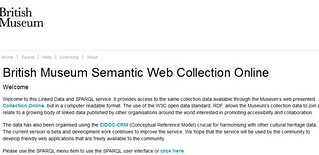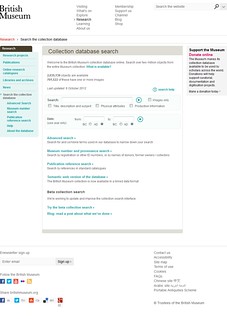Screenshots


Contacts
Dominic Oldman, Information Systems department, British Museum
Project URLs
Follow their progress at: http://www.researchspace.org/project-updates
Machine-readable data link: http://collection.britishmuseum.org/Sparql
Documentation: http://collection.britishmuseum.org/Sparql/Help
License: http://collection.britishmuseum.org/Licensing
Sandpit: http://collection.britishmuseum.org/Sparql
Press release: http://www.britishmuseum.org/about_us/news_and_press/press_releases/2011/semantic_web_endpoint.aspx
What's available?
(List license if different from default)
Includes metadata? Yes
Includes data? Yes
Includes digital surrogates? ?
Data interface type(s) and format(s)
SPARQL endpoint; REST API
RDF/XML; Notation-3; Tutle; JSON
Ontologies, vocabularies
CIDOC-CRM
Licence(s)
'version 1.0 of the British Museum’s Open Data Licence' ... 'aligned to be interoperable with any Creative Commons Attribution Licence, which covers copyright, and Open Data Commons Attribution Licence, which covers database rights and applicable copyrights'.
Project summary
Date started:
Date launched: September 2011 (beta)
Reason/motivation: "The British Museum is committed to making its collection, and data relating to the collection, accessible to a global audience both physically and virtually. Collection Online, the British Museum’s web database implemented in 2007, already allows visitors to the Museum’s web site to search nearly 2 million object records, a third of which currently include at least one digital image.
The British Museum has now released a Semantic Web version of the database complementing the Collection Online search facility. The Museum is the first UK arts organisation to instigate a Semantic Web version of its collection data. The new service brings the British Museum into the ‘linked data’ world and will allow software developers to produce their own applications that can directly manipulate and reuse the data. It will also allow researchers and scholars a way to search and find data more precisely and facilitate automatic updates.
This Semantic version has been enhanced by applying the CIDOC-CRM (Conceptual Reference Model) ontology. By converting data to this ISO accredited semantic framework the potential to harmonise and build data relationships with other organisations is greatly enhanced. In addition, the service comes with a more open data licence encouraging wider reuse.
Dominic Oldman, IS Development Manager, British Museum said ... "This new Semantic version [of Collection Online] will provide a new degree of accessibility, and allow others the ability to work closely with the data, obtain new insights and produce innovative applications.”" Source: http://www.britishmuseum.org/about_us/news_and_press/press_releases/2011/semantic_web_endpoint.aspx
Partners/funders/provocateurs, etc: "ResearchSpace is an initiative generously funded by the Andrew W. Mellon Foundation."
Linked from relevant main site sections? Yes, from http://www.britishmuseum.org/research/search_the_collection_database.aspx
Designed for use internally? Yes.
Reception, comments, things made with it
Experimenting with British Museum data - an excellent post from Owen Stephens outlining some of the issues he encountered trying to explore the SPARQL endpoint and the CIDOC-CRM modelling.
PHP Class to interact with British Museum data - a PHP class on GitHub by Eric Kansa
British Museum Collections discussion and feedback - open discussion for people trying out the British Museum data service
Comments (1)
Mia said
at 7:06 pm on Oct 11, 2012
I've started making some case studies for a talk, so I thought I might as well share them as a resource. This also means you can correct any errors you see - please just go ahead! And add fields if you think some useful information is missing.
Cheers, Mia
You don't have permission to comment on this page.